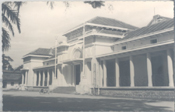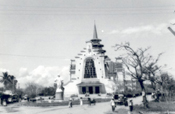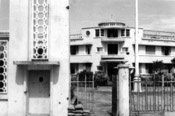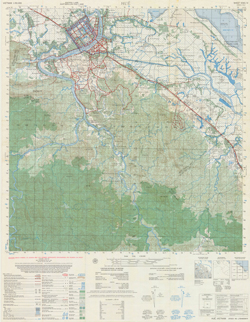The Tet Offensive (Tết Mậu Thân)
- The Tet Offensive (Tết Mậu Thân)
- Hue: The Imperial City
- The Battle of Khe Sanh
- The Battle for Saigon
- Aftermath of the BattlesPolitical ConsequencesExhibit Credits
Hue

University of Hue: Administration Building Office of the Rector, 1960
(Douglas Pike Collection: Other Manuscripts - American Friends of Vietnam [va005506])
Hue Cathedral. This was a Communist stronghold during the Tet offensive...
(Tommy Carver Collection [va031727])The battle for the city of Hue during the Tet Offensive of 1968 was one of the most iconic, yet incongruous, events of the American war in Vietnam. Iconic because of the fierceness of the fighting in the city, pitting the hardened troops of the People’s Army of Vietnam (PAVN) and Viet Cong (VC) against the city’s battle-tested and stubborn defenders: United States Marines and the Army of the Republic of Vietnam (ARVN). The photos and journalistic reports emerging from the battle are among the most powerful and memorable of the war. Yet the combat that began in late January and continued throughout nearly the entire month of February is incongruous in that the urban fighting of this monumental battle was unfamiliar for all sides involved, and indeed uncommon throughout the entire war. When the fighting ended, the once beautiful and pristine cultural capital of Vietnam lay badly damaged, and thousands of warriors and non-combatants were dead, with many thousands more suffering from severe injuries, and tens of thousands of refugees were left to pick up the pieces of the Imperial City.
Hue was a city of contrasts. Divided physically by the Perfume River, Hue was also divided into the ancient and the modern. Serving for centuries as the cultural and intellectual center of Vietnam, north of the river Hue was home to Buddhist monasteries, ancient Vietnamese shrines, and countless reminders of the history and tradition of the Vietnamese people. Yet this old and bucolic section of the city was dominated by the massive and foreboding fortress known as the Citadel. This concrete structure consisted of high walls, towers, and ramparts, and covered nearly one square mile of the northern part of the city. South of the Perfume were the manifestations of the city’s modernity: governmental complexes, a university, a prison, medical facilities, and the multitude of other administrative offices necessary to tend to the city’s 140,000 inhabitants.
Until the Tet Offensive, Hue was largely untouched by the war. The Saigon government wanted to preserve the city’s rich history—in part to help buttress the government’s claims to true Vietnamese nationalism—and toward this end forbade the use of heavy weapons, artillery, and air strikes in the city as a matter of course. Reluctant to destroy the city’s cultural heritage—and unwilling to provide grist for Saigon’s propaganda mill—Vietnamese communist forces spared Hue for most of the war. So, during this grinding war of attrition throughout South Vietnam, the city of Hue stood as a place of peace, enduring as the country’s eternal "lotus flower" through the tempest of war.
Vietnam Center & Sam Johnson Vietnam Archive
-
Address
Texas Tech University, Box 41041, Lubbock, TX 79409 -
Phone
(806)742-9010 -
Email
vnca@ttu.edu



